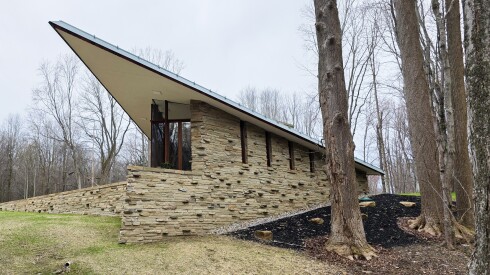Overshadowed by its larger and more well-known cousins, Palenque and Chichén-Itzá, Uxmal (“Oosh-mahl”) is the ruins of an ancient Maya city located near present-day Campeche. In its heyday, Uxmal was one of the largest cities of the Yucatan peninsula with a population of about 25,000 Maya. Today, it is a UNESCO World Heritage site. Ancient Maya architecture in this part of Mexico is referred to as Puuc architecture, and Uxmal is a prime example of this style. Though there are some Puuc structures in Chichén-Itzá, Uxmal is unique in all of Mexico. Puuc design is most notable for buildings with a plain lower façade and a richly decorated upper façade. Carvings most commonly found include serpents and latticework. Uxmal is dedicated to the Maya rain god, Chaac, and you can see his image everywhere. On the day we were here, it was blisteringly hot and humid; I could’ve used some rain! When I first laid eyes on the four buildings that make up the complex known as the Nunnery Quadrangle, I thought they were the most elegant Maya ruins I had ever seen. The clean lines of the buildings give them a modernity that is surprising considering Uxmal was built more than 1,000 years ago! The carvings on the upper facades are just spectacular and give the entire structure a very delicate feel. Uxmal is located close to Chichén-Itzá, so if you go to Chichén, consider going a bit further to visit Uxmal. You won’t regret it!
More Recommendations
Elegant Maya City
Overshadowed by its larger and more well-known cousins, Palenque and Chichén-Itzá, Uxmal (“Oosh-mahl”) is the ruins of an ancient Maya city located near present-day Campeche. In its heyday, Uxmal was one of the largest cities of the Yucatan peninsula with a population of about 25,000 Maya. Today, it is a UNESCO World Heritage site. Ancient Maya architecture in this part of Mexico is referred to as Puuc architecture, and Uxmal is a prime example of this style. Though there are some Puuc structures in Chichén-Itzá, Uxmal is unique in all of Mexico. Puuc design is most notable for buildings with a plain lower façade and a richly decorated upper façade. Carvings most commonly found include serpents and latticework. Uxmal is dedicated to the Maya rain god, Chaac, and you can see his image everywhere. On the day we were here, it was blisteringly hot and humid; I could’ve used some rain! When I first laid eyes on the four buildings that make up the complex known as the Nunnery Quadrangle, I thought they were the most elegant Maya ruins I had ever seen. The clean lines of the buildings give them a modernity that is surprising considering Uxmal was built more than 1,000 years ago! The carvings on the upper facades are just spectacular and give the entire structure a very delicate feel. Uxmal is located close to Chichén-Itzá, so if you go to Chichén, consider going a bit further to visit Uxmal. You won’t regret it!
Ruta Puuc | Puuc Route
Maya architecture differs by area and historic period. The architectural tradition known as Puuc features intricate facades and mosaics rising from concrete foundations. The Ruta Puuc is a 25-mile itinerary of roads that pass many examples of the style. Its largest representative site, Uxmal, is justly acclaimed for impressive structures like the so-called Pyramid of the Magician and the Nunnery Quadrangle. That said, every Puuc location offers something unique, from masks depicting the rain god Chac at Kabah, Labná’s arched gateway, or the Grand Palace at Sayil. Though not typical of the Puuc style, the fascinating Maya paintings at nearby Loltún Cave also merit a stop-in.
Awesum ruins without the crowds
Skip all the crowds, and enjoy the Mayan ruins at Uxmal. Every bit as beautiful as other more well know ruins, but at a much slower pace. Definitely worth the trip!
Puucing Around the Yucatan
Uxmal is a large Maya archaeological site located in the northwestern Yucatan, approximately an hour south of Merida. Uxmal saw its zenith during the late Classical Period (750-1,000 AD) and is the largest and best preserved of the regional sites known collectively as “Puuc”. The Puuc sites are characterized by their exterior stone decor that features Chaak masks with a long upturned nose and serrated teeth and monster faced temple facades with a gaping toothed mouth as the entrance. The Puuc sites are conveniently connected by a well posted road called the Ruta Puuc. There are about five archaeological sites on the route, which includes Uxmal, Kabah, Xlapak, Labna and Sayil. Additionally, the Loltun Caves and Cacao Museum should not be missed. The Ruta Puuc seems like a good day trip from Merida, but it’s actually a very long hot day to include everything and an hour plus drive there and back. I would strongly recommend staying at a hotel near Uxmal, so you can start there before the tour buses arrive and continue the route one step ahead. The Hacienda Uxmal is located at the archaeological site and is a great place to start and finish your exploration of the Ruta Puuk. You can start at Uxmal in the morning, before the crowds appear and finish by seeing the site lit up with technicolor lights from the hotel pool.
The Governor's Palace
The Governor’s Palace in Uxmal is a long low building with a huge platform of Pre-Colombian facades on top.


































